What Are The Different Types of Digital Ads?
Our Guide Will Walk You Through All Things - Digital Advertising
“Stopping advertising to save money is like stopping your watch to save time.” - Henry Ford
It only took around four years for the internet as we know it to exist before the first type of digital advertising reared its head. We’ve come a long way since then, but next time your YouTube video is interrupted by an unskippable 30-second ad, you can thank the innovative minds at AT&T for their groundbreaking 1994 banner ad.
Digital advertising has grown and evolved into many different forms, and running good online ad campaigns has become an art form you can literally write a PhD thesis on. But you don’t have to be a marketing genius to harness the power of online advertising.
If you’re looking to expand your paid digital presence, but just ran your first Facebook ad campaign yesterday and still don’t know your PPC ads from your elbow, you’ve come to the right place. Let’s talk ads.
Chapter One: What are Digital Ads?
Digital advertising occurs when marketers or business owners promote their organization on the internet. In order for consumers to see the advertising efforts, they must be actively using the internet in some form.
With the average internet user spending 6.5 hours online every single day, you have a pretty good chance of reaching them on the web. And by “on the web” we mean, checking their email, scrolling through Instagram, searching for brunch recipes or reading a page about the different types of digital advertising.
Digital advertising gives marketers the ability to run an ad for 30 minutes and immediately know how much money they spent, how much they made, how much web traffic the ad got them and how much they would make if their ad ran for ten minutes on the planet Jupiter. One of those things we made up, but much of the allure of digital advertising really is its ability to deliver hard data that can be analyzed to the smallest detail and used in future campaigns.
There are also several things that digital ads are decidedly not.
- Free. And sometimes not cheap, either. Digital advertising is an inorganic form of advertising that requires you to open your heart and your wallet, which is why it’s critical that marketers get so much detail on their ad performance. If you’re consistently seeing high losses, it may be a sign that it’s time to restrategize to bump up your ROI.
- Traditional. The opposite of digital advertising is widely considered to be traditional forms of advertising, or any ads that did not require the internet for delivery. That means print ads, radio ads, non-electronic billboards, T.V. ads, etc. These ads have a place in the media mixes of many successful companies, but most mid-level marketers find it more effective to go digital. Why? Mostly because of the ad targeting abilities and performance data digital ads deliver that we mentioned above. Traditional ads often used the infamous “spray and pray” approach, plastering their message to large audiences and hoping it would resonate with someone. It’s much easier to target your audience and have control over your ad delivery online.
These are the main types of digital advertising most often used by marketers.
Chapter 2: What are Social Media Ads?
In 2004, one Mark Zuckerberg changed the course of history with “The Facebook,” a social networking platform originally designed for college students. It wasn’t until 2006 that J.P. Morgan Chase realized the potential of such a site and signed a deal to promote its credit cards on Facebook. Fast forward to today and now we’re all getting personally victimized by Instagram ads that claim you can’t live your optimal life without a $400 commuter bag for working millennial females ages 24-35 who enjoy hiking on weekends and never eat the crust on their pizzas..png)
Now marketers have a smorgasbord of social media platforms to choose from, including Facebook, Instagram, Twitter, Pinterest, LinkedIn and beyond. The platform you decide to ultimately place your ads on depends on a number of factors, but the factor you should consider above all things is your audience’s online habits.
Sure, “everyone” is on Facebook (or at least 22% of everyone), but that doesn’t mean it’s the best place to reach your target market. Do some digging and find out where they actually spend most of their time. Ideally, you should ask your customers themselves with interviews and surveys, but at the very least you can Google which demographics generally reside on which social networks. That way you’re setting up your ads for success from the start.
Dive Deeper: Podcast Episode 124: Social Media in 2020
From there, you can move into ad formats. The format you choose to use depends on your messaging, budget and the platform you’ve selected. Targeting LinkedIn users with InMail that goes directly to their message inbox is effective, but might be way out of your price range. Placing feed ads on Facebook may be cheap, but without intriguing imagery you may not attract the valuable attention of your audience.
Do your research and establish clear goals for your ads.You can use social media ads as part of your strategy to increase sales or just to build brand awareness and goodwill on a wider scale. There’s no “right” goal, but when you decide to become the brand that targeted users see on their feed an estimated 600 times per day, you’ll need the strategy to back it up.
Setting up social media ads comes with a lot of moving parts and details to keep track of. When setting up your ads, these are the top five things you need to double check.
1. URLs and UTMs
Ensure you’re directing users to the correct URL. Your URL should include a UTM tracking parameter that adds specificity to your reporting in tools like Google Analytics.
2. Creative Boundaries
Facebook and Instagram stipulate that any imagery or creative accompanying your ads should contain only up to 20 percent text. Both platforms will reject your ad if the system detects too much text. Use minimal text in your ad creative and save your message for the copy.
3. Ad Formatting
Use handy tools like Facebook’s Creative Hub to review your ad’s formatting, graphics and copy and preview what it will look like in the wild. You can use the Creative Hub to collaborate with teammates and get a second pair of eyes on your ad to double check that it’s ready for its close up.
4. Targeting
Take a minute to review the audience you’re targeting with your ad. Do you know your audience inside and out? Will this ad reach them and resonate? Consider this: 80% of users follow at least one brand account on Instagram, and 30% of this group have purchased a product they discovered on the ’Gram. With social ads, both B2B and B2C businesses have the targeting tools to get their product in front of the specific audience that’s most likely to buy. Dive Deeper: How to use Geotargeted Ads For Your Business
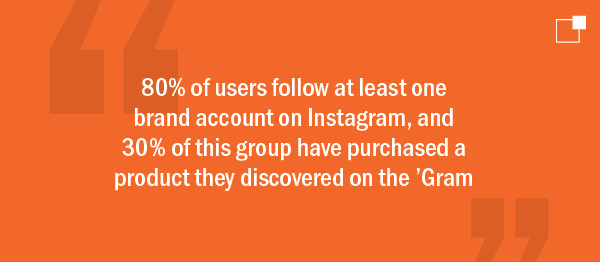
5. Budgeting
Make sure there are no extra zeros in your budget by mistake! But also, ensure timing and budget are set correctly. Ads should run for at least five days before getting a good measure of their success. Minimum spend depends on your industry’s average search volume for common terms. Smaller and more niche industries should spend a minimum of $25 per day whereas larger brands should start at $500 per day minimum, especially if they operate in the e-commerce sector.Social media ads are a never ending process, which is great for social media managers’ job security, but terrible for our sanity. Just when you thought you’ve mastered the art of the social media ads, they flip the script on you, adding a new type of ad or changing targeting and budget methods or...algorithms! Because the process is unending, you must always be learning.
Dive Deeper: Boost Your Social Media Ad Performance
Chapter Three: What are Display Ads?
Social media ads are more of an everyman’s ad. It’s fairly simple to find Facebook’s Ad Manager or Twitter for Business and set up a quick ad. But have you ever wondered how ads in the middle of webpages or on banners and sidebars are purchased?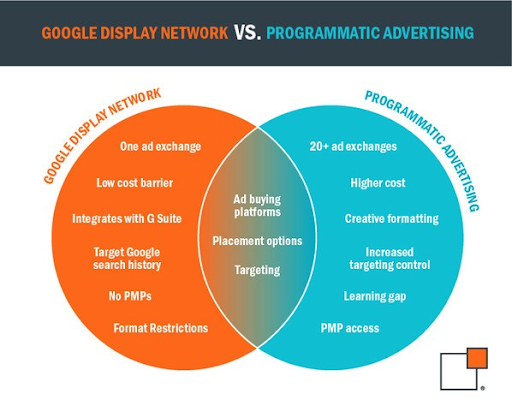
These types of digital ads are known as display ads, a more complex type of digital advertising. In order to run display ads, you will need a third party platform, the same way you need Facebook’s Ad Manager to run Facebook ads. But there are generally two ways to enter the world of display ads: the Google Display network or other programmatic advertising platforms.
Let us explain.
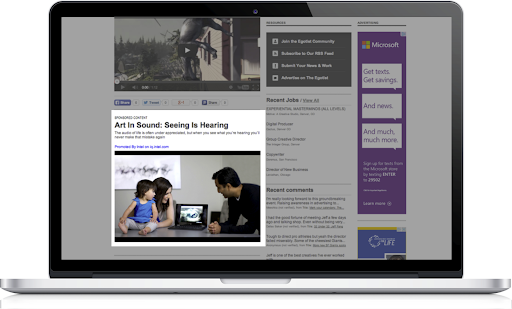
The sponsored content in this example is a native ad on the GDN. The network, which spans more than 2 million websites, will show your ads to a targeted audience, allowing you to find new customers or engage existing ones. Ads you can run include:
- Responsive Display Ads allow you to upload your imagery, logo and text to create an ad that can be shown in several formats. These ads then appear in between paragraphs, on sidebars and blend throughout a site.
- Uploaded Image Ads can only be shown in the format you upload them and are treated as one image rather than an image with separate text elements. This gives you more control over appearance but can lead to formatting issues.
- Gmail Ads are simply the image ads shown at the top of inboxes for users with Gmail accounts.
- Engagement Ads are more advanced visual ads. They include an element of engagement that can better catch the audience’s attention. For example, a B2C company could run an ad that looks like a regular image advertising one product, but when you roll over the ad it expands to show their full product line.
Dive deeper: Podcast Episode 115: Advertising on Google
The GDN is a great choice because it integrates visually rich ads throughout the user’s regular web experience rather than just displaying easily overlooked text.
Meanwhile, programmatic advertising is the automated buying and selling of digital ads using software (other than Google’s). Many formats and channels are supported with programmatic advertising. Ads can be placed on mobile, desktop, tablet, connected TV and more. They can be placed in several formats:
- Image ads containing text and image, similar to the Google Display Network above.
- Audio ads that appear in podcasts, internet radio and music streaming platforms like Spotify.
- Video ads which can appear as native ads blended throughout a webpage or in-stream within certain video players. Note that they cannot be placed on YouTube as it is strictly part of the Google Display Network.
Dive deeper: What’s the Difference Between Google Display Network and Programmatic Ads?
Dive even deeper: Native Advertising vs. Programmatic Advertising
Chapter Four: What are Video Ads?
You might be thinking, hey wait! Can’t video ads be social media advertising or display advertising? Why do they get their own section?The short answer is because video advertising is truly its own beast. When marketers talk about “video advertising,” they’re generally referring to one of two definitions:
The advertising content that plays before, during and after streaming video content.
All video advertising, including streaming ads, display ads and native ads.
So, yes, while video advertising can technically be a tactic in social media or display advertising, it really goes beyond these platforms. For example, YouTube is a huge streaming platform (not a true social network) that shows so many advertisements per day that some marketers consider it to be their primary and only video ad network. For others who make use of social media or programmatic ads, the definition is a bit more broad.
Dive deeper: YouTube Advertising 101: Your Guide For Success
Bottom line: You’re focused solely on YouTube or you’re focused on multiple channels. Either way, video advertising is much different from putting together a nice carousel ad on Facebook or promoting a tweet with an accompanying photo. It requires you to actually have original video content on hand and ready for public viewing.
Fear not! Getting started with a video advertising strategy is like getting started with any strategy. The best place to start is with your goals.What exactly is your objective in investing time and money into video? Is it brand awareness? Increased sales? Your goals have a huge impact on your overall approach.
It also helps to dig a little deeper into the goals and challenges faced by your target audience. Determine what the audience’s problem is and how you can address or solve it. This will provide a little support for your goals and your overall content and targeting methods.
With this baseline knowledge in mind it’s then time to create the visual content that tells your brand’s story, addresses the consumer’s needs and sticks with your audience. Easy peasy.
Just kidding. That’s a daunting task! To help you out, we suggest using the Hero, Hub, Help video content model. Hero, Hub, Help provides a framework for structuring your video content by classifying your videos under one of three categories:
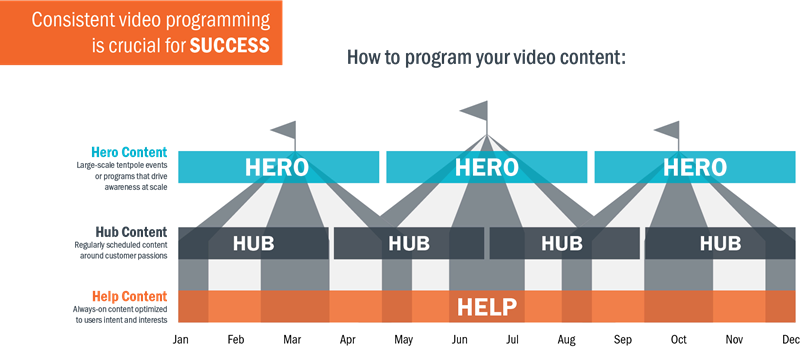
Hero
Your BIG content! This is your best work that you want pushed to a big, broad audience. You should have only a few of these videos per year and they will most likely form the foundation of your advertising content.Hub
This content is deployed on a regular schedule and gives a different perspective on your Help content. It includes behind the scenes content, and fun, entertaining videos.Help
What questions does your audience have? What knowledge are they actively seeking? This content encompasses product-related and how-to videos and is generally evergreen.Use this framework to determine the type of content you want to promote, then factor in your research from earlier on your audience’s goals and challenges. This will give you a concept for your video content.
Dive deeper: Hero Hub, Help: Get Started with a Video Content Marketing Strategy
Your next step to launch is determining your ad type. An ad type dictates where, when and on what devices you want your content to appear. There are several factors to consider.
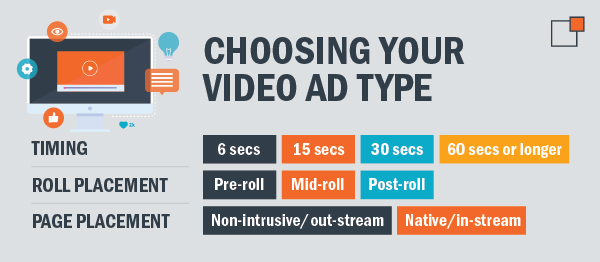
Timing
Will your ad be six seconds, 15 seconds or 30 seconds? Will you create various ads with the same concept, but different lengths? Remember that many longer video ads can be skipped or ignored, but it can be hard to fit your message into a mere six seconds. We suggest running multiple ads (with one concept or different concepts) and testing their lengths based on engagement results.Roll placement
This factor applies to video ads that occur within streaming content. Your ad can be shown before the video (pre-roll), in the middle of it (mid-roll) or at the very end (post-roll). Your ad may be more appropriately placed at a certain time or your budget may only be able to accommodate less expensive, post-roll ads.Out-stream vs. In-stream
This factor applies to programmatic ads. Out-stream video ads are non-intrusive and appear in sidebars and banners. In-stream ads are native, located within the page or text. Is your ad eye-catching from the sidebar or does it need to be placed within the page for a little boost.This type of digital advertising requires more upfront work, but can have a better chance of grabbing your audience’s attention. Always go back to the basics with video advertising and make sure you’re putting out a quality piece of video that entertains and informs without getting passed over by the dreaded Skip Ad button. Having great video content at the core of your campaign can truly make or break your success.
Chapter Five: What are PPC Ads?
Of all the types of digital ads, pay-per-click, or PPC, campaigns are the easiest way to pay to drive traffic to your site. They can bring in new audiences and help you increase sales by marketing to a ready-to-buy audience.PPC campaigns are built on a foundation of keywords, which makes sense when you consider that search engines are the most popular platform for running these campaigns. GoogleAds is the go-to platform for PPC efforts, but many other search engines, including Bing, offer PPC options.
Using GoogleAds, marketers can specify a list of keywords they want to target. Then, if a user searches that keyword, the marketer is entered into a bidding war with several competitors targeting the same keyword. The ad that ultimately appears in the user’s search depends on several factors, including how much the marketer bid, how relevant their site is to the keyword and their overall ad text.
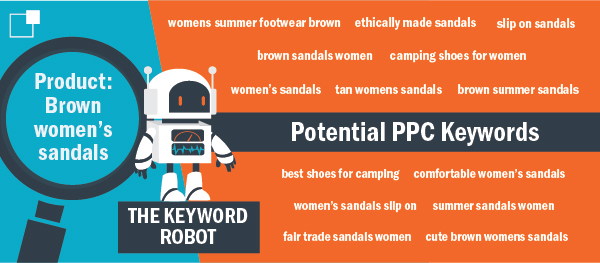
If Google’s algorithm wins in their favor, the marketer’s ad will appear at the top of the page. If the user clicks on the ad, the marketer pays. If they do not click, the marketer is not charged, but can still hope they got some brand awareness out of the deal if the user took a moment to read their ad.
PPC ad campaigns are great because they allow you to target your audience on your own terms and within your own budget. But they can be complex because they require an intimate knowledge of the system. It also helps to have a really good idea of what your potential customers are searching to find you, which can be tricky to unearth.
With all the complexities, managing PPC campaigns can be a full-time job. That’s why it’s important for marketers to work smarter, not harder in determining the keywords they want to target.
Chapter Six: What are Digital Out-of-Home Ads?
Have you ever been to a mall and found kiosks with screens that project advertisements for stores within the building? Or went to a healthcare facility and watched a television advertising the hospital’s services? Or have you seen a billboard on the highway with a digital screen that changes every time you drive past?If you answered yes to any of these questions, then you’ve met digital out-of-home advertising (DOOH), a fast-growing type of ad that puts a modern spin on traditional media. Any digital advertisements that appear on a screen in a space accessible to the public are considered to be DOOH.
Dive deeper: Digital Out-of-Home Advertising Types and Trends
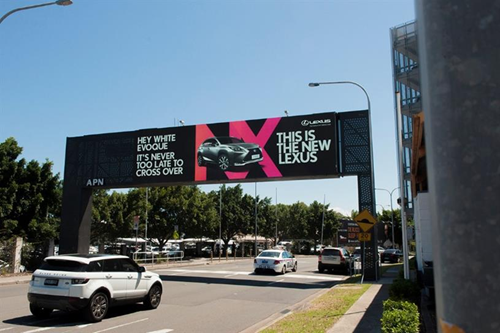 For example, smart billboards are catching consumers’ eyes by personalizing messages in unexpected ways. Cameras along with the right software can determine the type of car someone is driving and, in real-time, create and serve an ad customized to the individual driver.
For example, smart billboards are catching consumers’ eyes by personalizing messages in unexpected ways. Cameras along with the right software can determine the type of car someone is driving and, in real-time, create and serve an ad customized to the individual driver.Screens in restaurants are showing real-time posts from users who share pictures of their food using a specific hashtag. At street level, advertisers are using cameras and AI capable of facial recognition to deliver unique messages or even engage in games with the individual passing by. Companies that sell warm-weather products are only advertising on billboards when the weather is above 75 degrees.
 OOH ads in general put your message in places where large amounts of people are almost guaranteed to see it, making it a great tool for brand awareness. Plastering your message on the side of the highway or on the exterior wall of a bus stop in a busy city are great techniques for widespread reach.
OOH ads in general put your message in places where large amounts of people are almost guaranteed to see it, making it a great tool for brand awareness. Plastering your message on the side of the highway or on the exterior wall of a bus stop in a busy city are great techniques for widespread reach.But out of all the ads on our list, DOOH may give the most freedom for creativity and risk. A cool ad can stick out in consumer’s minds and make it onto a social medium platform where it will be widely shared for free. According to Nielsen, one-in-four Americans has posted an image of an exciting out-of-home advertising ad they saw on a social platform.
And even if it’s not an AI-based ad that recognizes cars, it’s still pretty cool to customize your ads to run on certain boards at certain times or under specific conditions. All the fun of traditional, eye-catching advertising but with the added bonus of control that comes with the digital ad space.
Dive deeper: Measuring Success with Out-of-Home Ads
Chapter Seven: How do Different Ads Work Together?
You may have picked up on a few connections throughout this article. For example, video ads can be placed on social media platforms and run as social ads. But when videos are run through the Google Display Network to show on YouTube, then they’re display ads. But if you broadcast them onto the Jumbotron at a Lakers game, then they’re digital out of home ads. And if you run them within a streaming service that’s not YouTube, then they’re just plain video ads. Confused yet?One thing’s for sure: ad types are like potato chips. A marketer rarely ever uses just one. The complex network of digital advertising options is vast, but it allows marketers to choose the combination of advertising formats and platforms that best reaches their audience and works for their brand and budget.
Concentrating on more than one channel or platform at a time is called multichannel marketing, and it’s an art we would estimate exactly zero marketers have mastered. It’s not easy to keep track of so many moving parts, but advertising on multiple channels maximizes your strategy and allows you to reach a wider audience with the same campaign. It is also designed to give the user freedom of choice in how they want to interact with you. Maybe they love seeing your fun posts on Instagram but will set an advertisement on fire if it ends up in their mailbox.
When creating a multichannel marketing strategy, it's important to carefully choose a few KPIs that help capture your business goals. We've recently written a piece on measuring incremental sales, one KPI that we feel is important.
Most marketers are already conducting some form of multichannel marketing, but it always seems like the second we get the hang of the balancing act, there’s a new advertising channel in town. This expansion of channels requires marketers to adapt, buckle down and always be learning more.
Dive deeper: The Benefits of Multichannel Marketing
